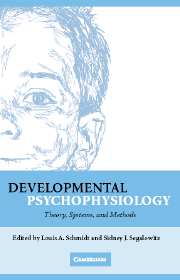Book contents
- Frontmatter
- Contents
- Foreword by Stephen W. Porges
- Preface
- Acknowledgments
- Contributors
- 1 Capturing the Dynamic Endophenotype: A Developmental Psychophysiological Manifesto
- SECTION ONE CENTRAL SYSTEM: THEORY, METHODS, AND MEASURES
- SECTION TWO AUTONOMIC AND PERIPHERAL SYSTEMS: THEORY, METHODS, AND MEASURES
- 7 Infant Heart Rate: A Developmental Psychophysiological Perspective
- 8 Examining Cognitive Development Using Psychophysiological Correlates: Evidence of a Hierarchy of Future-Oriented Processes Across Measures
- 9 Measuring the Electromyographic Startle Response: Developmental Issues and Findings
- 10 The Measurement of Electrodermal Activity in Children
- SECTION THREE NEUROENDOCRINE SYSTEM: THEORY, METHODS, AND MEASURES
- SECTION FOUR DATA ACQUISITION, REDUCTION, ANALYSIS, AND INTERPRETATION: CONSIDERATIONS AND CAVEATS
- Index
- References
7 - Infant Heart Rate: A Developmental Psychophysiological Perspective
from SECTION TWO - AUTONOMIC AND PERIPHERAL SYSTEMS: THEORY, METHODS, AND MEASURES
Published online by Cambridge University Press: 27 July 2009
- Frontmatter
- Contents
- Foreword by Stephen W. Porges
- Preface
- Acknowledgments
- Contributors
- 1 Capturing the Dynamic Endophenotype: A Developmental Psychophysiological Manifesto
- SECTION ONE CENTRAL SYSTEM: THEORY, METHODS, AND MEASURES
- SECTION TWO AUTONOMIC AND PERIPHERAL SYSTEMS: THEORY, METHODS, AND MEASURES
- 7 Infant Heart Rate: A Developmental Psychophysiological Perspective
- 8 Examining Cognitive Development Using Psychophysiological Correlates: Evidence of a Hierarchy of Future-Oriented Processes Across Measures
- 9 Measuring the Electromyographic Startle Response: Developmental Issues and Findings
- 10 The Measurement of Electrodermal Activity in Children
- SECTION THREE NEUROENDOCRINE SYSTEM: THEORY, METHODS, AND MEASURES
- SECTION FOUR DATA ACQUISITION, REDUCTION, ANALYSIS, AND INTERPRETATION: CONSIDERATIONS AND CAVEATS
- Index
- References
Summary
INTRODUCTION
Psychophysiology is the study of the relation between psychological events and biological processes in human participants. The electrocardiogram (ECG) and heart rate (HR) have been commonly used measures throughout the history of psychophysiological research. Early studies found that stimuli eliciting differing emotional responses in adults also elicited HR responses differing in magnitude and direction of change from baseline (e.g., Darrow, 1929; Graham & Clifton, 1966; Lacey, 1959). Vast improvements in methods of measuring ECG and knowledge regarding the relation between HR and cognitive activity have occurred.
Heart rate has been particularly useful in developmental psychophysiological research. Researchers interested in early cognitive and perceptual development have utilized HR as a window into cognitive activity for infants before they are capable of demonstrating complex behaviors or providing verbal responses. Also, the relation between brain control of HR and the behavior of HR during psychological activity has helped work in developmental cognitive neuroscience. In this chapter, we address the use of the ECG and HR in research on infants. We review three ways in which HR has been used in psychophysiological research: HR changes, attention phases defined by HR, and HR variability (particularly respiratory sinus arrhythmia). Topics we focus on are the areas of the brain that are indexed with these measures, developmental changes associated with these measures, and the relation of these measures to psychological processes. Before covering research with infants, we briefly review background information on the heart, the ECG and HR, and its relation to psychophysiology.
- Type
- Chapter
- Information
- Developmental PsychophysiologyTheory, Systems, and Methods, pp. 173 - 212Publisher: Cambridge University PressPrint publication year: 2007
References
- 11
- Cited by



